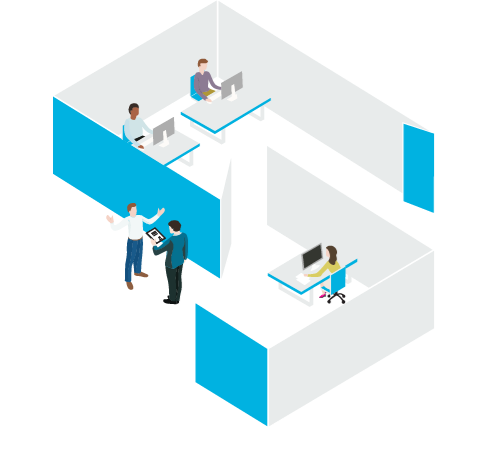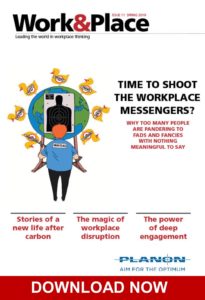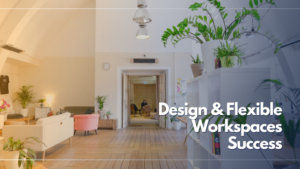New concept of office space layout and way of thinking about work, the flex office is gradually becoming a part of the life of French companies.
Reduction of real estate costs, increased productivity, mobile employees, digitization of the building and employees, emphasis on well-being at work…: flex office can only seduce.
But if this model of flexibility makes emulators, it also faces difficulties of setting up: new managerial position to adopt, employees disoriented, expenses of redevelopment…
So, flex office, magic solution or whim of a new generation of workers? What appraisal do pioneering companies of shared offices have after their passage through flex office? Focus on what works and does not work with the examples and cases of French companies that have crossed the step of “no fixed office”.
Flex office, a revolution in the world of work
Work flexible and collaborative
With flex office, here is the open space relegated to the rank of ancestor of shared office! Now place to this new concept of development straight from the 1990s and large American consulting companies.
The principle is simple: more dedicated spaces but self-service workstations in shared, flexible and connected office spaces.
This modern working organization is dynamic and above all collaborative, like a nomadic generation that is revolutionizing the world of work. How? By providing the employee with a wide range of services both in the work itself and for its well-being…. Telework, project mode, hierarchy and management reviewed, work environments multiplied but also redevelopment of spaces, quality of life, diversified services… here are the advantages of the new way of working in flex office.
Companies embark on the adventure
While work and office space are changing, French companies are reluctant to change. 24% of employees believe that their company is lagging behind on digital transformation and only 42% “sensitized”.We still suffer from the misperception of power related to the individual office, the fear of data piracy, the complexity of standards that discourage, the fear of losing the cohesion of work with employees “free electrons”.
Meanwhile, to design a digital workspace today is to build the company of tomorrow!
It is thanks to the digitalization and the flexibility of shared spaces that we will be able to rethink the traditional models of organization in favor of open, efficient and profitable structures.
In fact, the trend of flex office sweeps especially on large companies such as Sanofi, PSA in last September, Bouygues Telecom or Danone: all have focused on a true digitalization of their company and a move to flex office. The concept is in all the minds of great leaders, flex office definitely has a bright future ahead.
“From now on, desk sharing is systematically being studied in space planning projects. Even if in the end the course is not necessarily crossed. “
But for these big groups, the transition was not made in a day. Pass to flex office is:
- rethink the wokspace
- adapt the medium and digitize the work of the collaborators to facilitate mobility
- display efficient tools
- rethink management and HR
It is not the General Bank that will contradict this idea. The bank has created The Dunes, a vast space of 126,000 m² where 9,000 employees have digital tools and services. Co-built with employees, The Dunes offer a wide variety of workspaces complemented by a rich offer of services – restaurant, fitness room, games room … Everyone chooses his space according to his needs.
Les Dunes – Société Générale
At Axa France, switching to flex office is an opportunity for a real cultural transformation. At the end of 2017, three buildings of the group will switch to flexible with a total of 2,000 employees who will evolve towards an activity-based spatial organization. A possible shift since 25% of employees already practice telework, for which Axa France has to equip and digitize.
 Majorelle // AXA Tower Defense
Majorelle // AXA Tower Defense
At BNP Paribas, when came the question about flex office in 2016, it was necessary to list a number of problems to be solved: move from 350 individual offices allocated to 15, from 80% of fixed computers to 95% of laptops, completely remove landlines for the benefit of 2500 smartphone. But equally create 1100 seats in the meeting room, storage, digital and collaborative sharing with 4 million digitized pages and even thinking about the realization of a “great place to work” at the subway exit, with fitness, concierge, auditorium and telecommuting deployed. And finally, transform management from a top down vertical logic into a horizontal logic based on accountability.
As we can see, choosing the flex office is not easy or risk free. So, miracle solution or multiple constraints?
Successful experience: assets of flex office
Interviewed for our white paper3, Olivier Pingeot of Saguez Workstyle already gave us the advantages of switching to flexible.
The rise of technologies required to rework the office differently than ten years ago, both as a performance lever and as related to these new technological uses. Nothing better than a move or the installation of a new office to embody this new strategy and set it up. The office layout now has a managerial dimension and HR, which has a real impact for the company.
Cost reduction
Mobile and nomad, the employee finally spends less time sitting at his post. Shared offices are often a way to optimize unused office space, estimated at 50 or 60% over the year in Paris. Flex office is indeed an economical solution: remove unused items for reuse by diversifying work environments and provide services useful to employees.
At Bouygues Telecom, the square meters recovered by flex office have created common areas: box, room creativity, quiet room. Here we bet 100 offices for 115 employees.
Flexibility
Imagine, computer and smartphone in hand, the employee moves to a different office every day and spends time in collective spaces like the cafeteria or lounge…. No more dedicated workstation for maximum flexibility. Employees are free to work where they want, in conditions that mostly suit them.
It is the “no fixed office” which allows these daily exchanges between employees of different services, which encourages decompartmentalize and improves creativity, which allows working in more pleasant work spaces.
Here is the time of well-being at work!
Get the meaning of communication and trust
Beyond the gain in health at work and especially in cost reduction, flex office is based on a question of management and communication. Traditionally organized into services and distinct territories, companies that dare to flex office have had to “break the silos” existing: employees can now regroup and exchange the time of a project. The transition to shared offices also serves to transform managerial practices. With a manager now installed in the heart of the team, impossible to ignore the problems of his employees.
The weaknesses of the concept
The attachment to the individual office
In an overview of French companies where the territory is important, where the position and even the size of the office is often a sign of power, no longer “own a space” can be complicated. Farewell customization of an office, it is now necessary to move with his personal belongings.
At Danone, the switch to flex office of the 6 floors of the group’s headquarters has imposed rules that may seem rigid: it is forbidden to drink or eat on the workstation, to go to a meeting without his business and the tables must be released if you do not come back before 15 minutes.
A disappearance of territoriality that can, more broadly, influence the feeling of belonging to a team. Leave part of oneself in the office, it is somehow an insurance find back our place the next day.
At Accenture, the forerunner of shared offices with boxes adopted in 1995, flex office has been slow to find its marks and prove itself. At first, the company had installed large open space in which it was necessary to reserve his office in the morning. A failure, the offices were deserted. Since then, all work situations have been identified – 200 in total – and fifteen work environments have been created to respond to them.
A rigorous organization to avoid isolation
Pushing the employee to change places every day can be ambitious and create isolation for his collaborators. Far from collaboration, flex office can also limit exchanges. Fatigue and lack of concentration can also be the perverse effects of shared offices. A sore point, far from being ignored by companies: Bouygues Télécom conducted an internal survey to find out the satisfaction rate of employees in flex office and 83% positively consider their new workspaces.
A new distribution in flex office can quickly become problematic for managers who want to gather employees involved in a project. Collaborating and meeting requires more organization in a flexible space. To counter this difficulty, Danone has relied on a multitude of collaborative spaces that provide more fluidity and reinforce exchanges. Bet won, we find in this giant Cac 40 employees working everywhere, from the kitchen to the living room through the rooms of silence, alcoves or meeting rooms, which previously empty, are now always full. And strict organization obliges, it is forbidden to reserve a room for the day, meetings are limited to one or two hours and confined spaces cannot be occupied more than four hours.
Master the deleted office spaces
Flex office can be catastrophic if it is not well controlled: be careful not to remove too many offices under penalty of destabilizing its employees. Sanofi, for example, has relied on an 80% occupancy rate, but some employees denounce a too massive removal of offices resulting in employees who wander to find a place and finally settle where they can, far from their team.
If flex office responds to the evolutions of work towards a nomadism and an ever increasing flexibility, it is not necessary to deploy the concept without real reflection of the project, without wanting to digitize its company nor without preparing or even integrating the employees to this change.
Well equipped and surrounded, and as the different examples of companies have shown, there is no reason not to succeed the project “without a fixed office”. The flex office in your company will not be done without:
– a total redevelopment of space
– a change management: communication and good practices
– create and simplify the use of flexible with the choice of digital tools like CoWork.io
The post Flex Office: a concept to adopt? Examples of pioneering companies of “no fixed office”. appeared first on CoWork.io.
Read Full Article from CoWork.io https://ift.tt/2m2ZbYD




